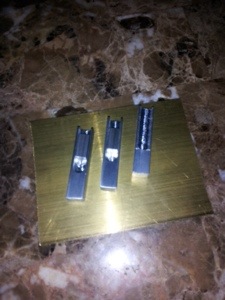So if you have read any of my posts you know that I have worked with “bell brass” quite a bit in the past as a tremolo block mass extender / enhancer. I use it generally when I do a custom project where the client is requesting a recessed tremolo variation. Since we loose a portion of the length of the block, I generally replace it with a shorter but fatter version. This really enhances the tone by sharpening and enhancing the usable frequencies-
I have taken this to the old style Jag / Jazzmaster bridge design as well. By enhancing the block, the tone benefits greatly. I have several of these designs available and have custom made them for Jazzmaster players around the world-
I have a new project I’m developing to travel to shows that uses multi-scale / fanned fret design. Currently, we are limited in our choices if we are designing an instrument. A designer I admire quite a bit has a system based on the ABM design. But I wanted to take my experience with the bell brass, and attempt to incorporate it into my design.
By mounting the entire system onto a precision machined bell brass plate then onto the body, frequencies are enhanced by the plate prior to being transferred to the body for final shaping. The plate can be mounted to the body directly or recessed (recomended)
I plan to make the new eX system available in virtually any scale / string configuration or design giving the builder and designer as many options as possible.
Enter my eX6+ (prototype) Bridge System. Each system is custom configured for the exact scale and string spacings requested as per the design. There are options for the saddle insert materials, Brass, Stainless Steel, Copper, Tusg, Bone or graphite- This gives you the ability to mix and match the materials to develope a truely unique instrument with the exact textures you desire / require for your compositions.
Each saddle has the option of insert material as well as height and precision intonation adjustment.
The saddle carriage and plate can be anodized providing a huge pallet of color options to match and enhance your design and provide exceptional protection.
This is in the prototype stage right now and I expect to have the first 6 string version tested in the next few weeks, check back soon. And as always, if you have any questions please contact me HERE



